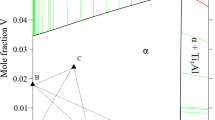Abstract
The simple non-Fickian model for the substitutional diffusion of an impurity in a III-V semiconductor proposed by Zahari and Tuck assumes that both the impurity and host atoms diffuse by a vacancy mechanism. Here we give an asymptotic analysis of the governing pair of coupled partial differential equations, obtaining analytical solutions for the impurity and vacancy distributions in systems for which the impurity diffusivity is much greater than that of the vacancies. Two problems are considered. The first is that in which the impurity concentration is initially zero and a prescribed concentration is given at the surface. The second problem models the diffusion of ion implanted impurity, for which initial impurity and vacancy distributions are specified and a condition of zero impurity flux is assumed at the surface. Both leading order and correction terms are obtained and in each case the solution predicts the anomalous ‘double profiles’ often observed in III-V systems. The ‘ion-implantation analysis’ also displays the observed phenomenon of ‘uphill’ diffusion against the impurity gradient close to the surface.
Similar content being viewed by others
References
Zahari, M. D. and Tuck, B.,Effect of vacancy reduction on diffusion in semiconductors, J. Phys. D, Appl. Phys.,15, 1741–1750 (1982).
Hearne, M. T.,Diffusion models for the doping of semiconductor crystals, University of Nottingham Ph.D. Thesis 1988.
King, J. R.,Mathematical analysis of a model for substitutional diffusion, Proc. R, Soc. Lond. A,430, 377–404 (1990).
Tuck, B. and Powell, R. G.,High-temperature diffusion of sulphur in GaAs, J. Phys. D, Appl. Phys.,14, 1317–1324 (1981).
Young, A. B. Y. and Pearson, G. L.,Diffusion of sulfur in gallium phosphide and gallium arsenide, J. Phys. Chem. Solids,31, 517–527 (1970).
Meere, M. G., King, J. R. and Rogers, T. G.,Estimation of parameters in the numerical modelling of nonlinear diffusion in semiconductors, Int. J. Numerical Modelling: Electronic Networks, Devices and Fields,3, 99–110 (1990).
Wilson, R. G., Jamba, D. M., Deline, V. R., Evans Jr., C. A. and Park, Y. S.,Depth distributions of sulfur implanted into GaAs as a function of ion energy, ion fluence, and annealing temperature and encapsulation, J. Appl. Phys.,54, 3849–3854 (1983).
Thompson, P. E. and Dietrich, H. B., MeV Simplantation into GaAs, J. Electrochem. Soc.,135, 1240–1244 (1988).
Author information
Authors and Affiliations
Rights and permissions
About this article
Cite this article
King, J.R., Meere, M.G. & Rogers, T.G. Asymptotic analysis of a non-linear model for substitutional diffusion in semiconductors. Z. angew. Math. Phys. 43, 505–525 (1992). https://doi.org/10.1007/BF00946243
Received:
Issue Date:
DOI: https://doi.org/10.1007/BF00946243



